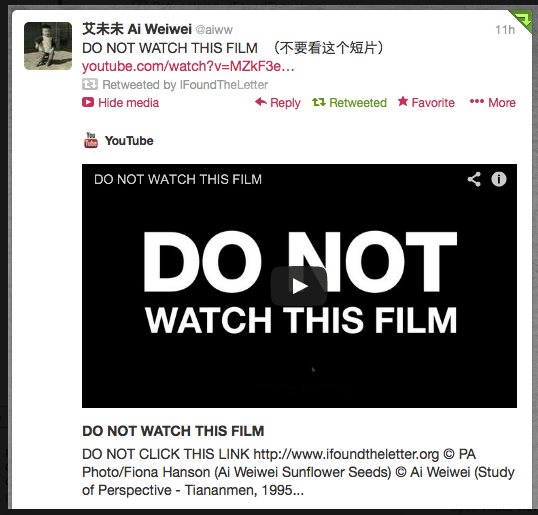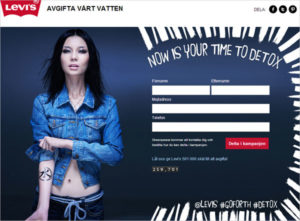This (very abbreviated) summary of human rights stories may sound familiar. Change a few details and it could describe many environmental or social justice issues:
An activist far away is arrested during a peaceful protest. They’re taken to a nameless prison — their basic rights to due process ignored. An NGO alerts newspapers, sends email and asks for action to pressure the party responsible.
When you hear human rights stories stories in the news (or stories of other large-scale issues such as climate change) you’re often thrown into the middle of a crisis with no idea how it came about. You likely have little personal connection to the story. Your relationship with the crisis is passive, maybe even depressing and demotivating.
Amnesty International recently tested a campaign intended to shatter the passivity often associated with “raising awareness.” The #IFoundTheLetter campaign ran for just over three weeks in August and used creative (even mysterious) online messaging that challenged people to immerse themselves in sharing actions and messages around their community, not online.
We had a chance to speak with Amnesty’s Sarah Atkinson, Sarah Sutherland and George Symonds about the campaign’s origin, goals, results and what they learned along the way.

I Found the Letter – Putin
Secret Mission: Rewrite the rules
Here’s a quick rundown of how users experienced #IFoundTheLetter:
Amnesty sent an invitation stating simply: DO NOT watch this video! The invitation was distributed through the @ifoundtheletter Twitter account, Facebook page, and the Amnesty International YouTube page. Social media and video guided people to the #IFoundTheLetter website where visitors were challenged to select a mission.
Cryptically written secret missions had various assignments such as “Disobey an arbitrary rule” and “Operation Free Expression.” Participants were given an equipment list and official “Authority Message” to edit and share. These messages included, for example, “Do not wave a rainbow flag” and “Do not voice your opinions” — participants were encouraged to voice their freedom of expression and disobey these “official” rules, of course.
Participants edited the letter using markers and placed their personalized authority message somewhere public for others to see and join in on the game. The attention-grabbing messages encouraged people to question current events and asked them to pursue their own secret mission. Participants were invited to share photos of their work on Facebook. The images of Putin above and Snowden below are two examples shared on the Facebook photo stream.

Participants were given full creative control. The organization stayed in the background, just giving a few ideas. “Audience content drives campaigns and inspires more action. Activism is about activists, not organizations,” said Amnesty’s Sarah Atkinson.
Takeaways
- Goal: Create an experience that helps people be excited about being activists.
- The project was implemented by a cross-departmental team working with limited access to organisational resources.
- #IFoundTheLetter was experimental — it was intended to test creative, deep engagement tactics in a measurable way.
- 46% of Facebook page fans were new to Amnesty International.
- 51% of video viewers clicked through to the website.
- 20% of visitors completed a “mission” and submitted edits – a high number given the high bar for completion.
A grand experiment inside and out
#IFoundTheLetter was in part a test: “can we use creative online/offline messages and actions to create a tangible experience for participants that gives them a sense of the experience a human rights activist has when taking action.” The test also sought to identify what engages people; ways of measuring participatory engagement in the field; how people react to fun or humorous challenges; and how to reach into new networks of participants.
As an experimental project, #IFoundTheLetter was not promoted broadly across Amnesty International’s communications channels and tested alternative ways of creating and distributing a campaign.
A small team of individuals across the International Secretariat of Amnesty International identified the scope of the project and their target audience (16-30 year olds in the global north that are active social media users). They spoke with different groups of young people about what motivates them to participate in social actions, what turns them off and what types of communications engage them.
The team worked across departments to get go-ahead for the approach and concept. Once given the green light (note: this wasn’t a covert operation internally), they built it rapidly outside the usual organisational campaign machinery and used their personal creative contacts to produce the design and feel they wanted.
Externally, the team wanted to test ways to use subvertising (hijacking and repurposing the messages of larger entities), pop culture and memes, gamification and the shift from broadcast campaign messages towards ongoing dialog with audiences.
Current events and culture provided rich content from gay rights crackdowns in Russia to Edward Snowden and revelations of NSA spying on Americans.
The look and feel of the site and secret missions supported the feeling that this was a disruptive, fun and glitchy game — it was an immersive experience but not one that place the weight of the world’s issues on participants. Twitter and, especially, Facebook, provided channels for two-way communication.
The team built a dialog with the community, deepening engagement. It’s a similar experience to that built by Greenpeace UK’s Chainsaw Barbie campaign.
Measurement, scale and impact
The team at Amnesty shared several data points that help explain both reach and what they were looking for from the campaign:
- 51% click through rate from the video onto the micro-site (half of those people went on to read a mission);
- 20% of people who engaged with the Facebook Page submitted an edited letter (high level of engagement);
- Video views: 16,043;
- Website visits: 11,175;
- Facebook likes: 637;
- It sparked conversation – it was picked up by several advertising, digital and marketing firms as well as individuals who are prominent in the digital campaigning space including Change.org, Upworthy, Dogooder and Adformatie.
One of the most exciting bits of feedback for the team came from artist and activist Ai Weiwei:

More interesting than the reach was the level of engagement. This was a time-intensive ask for people: there were multiple stages of action and it became riskier for participants to stay engaged as they moved to different challenges. Nevertheless 20% of people completed the ‘mission’ and submitted edits.
As the campaign went on, the creative engagement increased: contributions got more and more inventive and the community competed with one another. People wanted to use their creative talents to make something cool that could be shared on their social network profiles.
Amnesty gathered data (above) to measure impact but that assessment is still ongoing as staff talk with participants and people around the organization. The team was testing deep participatory engagement with an emphasis on creating a memorable experience for participants. They showed that people were engaged and they could spread the word to their target audience. It will take time to show if and how new participants stick with Amnesty or become further involved. #IFoundTheLetter was about engagement and relationships, not policy change. Deep relationships are a long game in campaigning with great potential but engagement metrics can’t be ad hoc. Even projects not aimed at immediate policy impact can produce data that flow into long-term outcomes.
What’s next for #IFoundTheLetter
#IFoundTheLetter was a contained experiment to engage people, get them excited and get them involved and doing good using creativity and fun. The campaign ran for just over three weeks and the Amnesty team doesn’t plan to revive it.
We can expect to see several of the tactics used woven into future, and broader, campaigns: participatory communication, user-generated content, gamification and art activism. It is exciting to see a global advocacy organization exploring ways to deepen relationships with and among citizen activists using online (to identify and engage) and offline (as an environment for action and spreading messages in tangible ways). As others have written recently, this level of connection can be hard for campaign groups to achieve but may be essential to long-term change.
A key question many campaigners may have is one of scalability. Can we take these participatory, dialog-driven tactics beyond small projects reaching a few thousand people? Sarah Atkinson at Amnesty International points out that Amnesty considers working across distributed networks as vital to its efforts to scale its impact on human rights upwards. Digital communications play a huge role for networked campaigning. Centralized organizations are struggling to adapt campaigns, communications and decision making to network speed and structure.
Thus far, the impact of #IFoundTheLetter has been its demonstration that creative and nimble campaigns can be developed that spread across online networks while having on the ground impact. Testing, measuring, analyzing and gaining confidence in this approach is an important step in centralized organizations working to be more effective across global networks of citizens and activists.
Want to find out more? Follow up with @sarahjatkinson and @huzzahsarah of Amnesty International.



